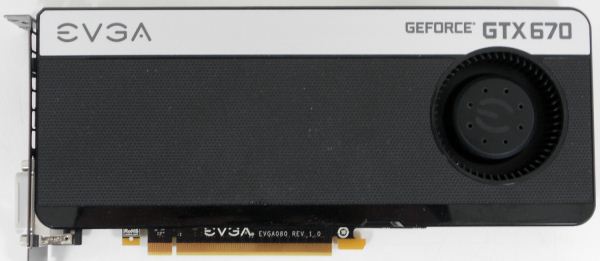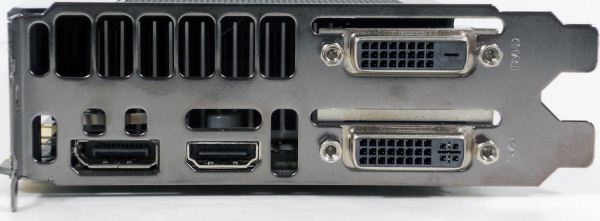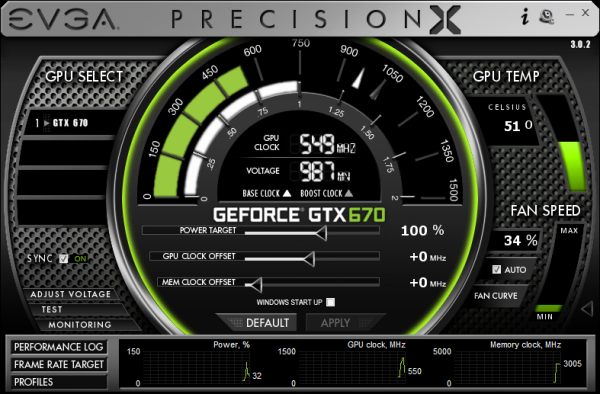NVIDIA GeForce GTX 670 Review Feat. EVGA: Bringing GK104 Down To $400
by Ryan Smith on May 10, 2012 9:00 AM ESTMeet The EVGA GeForce GTX 670 Superclocked
Our second card of the day is EVGA’s GeForce GTX 670 Superclocked, which in EVGA’s hierarchy is their first tier of factory overclocked cards. EVGA is binning GTX 670s and in turn promoting some of them to this tier, which means the GTX 670 Superclocked are equipped with generally better performing chips than the average reference card.
| GeForce GTX 670 Partner Card Specification Comparison | ||||
| EVGA GeForce GTX 670 Superclocked | GeForce GTX 670 (Ref) | |||
| CUDA Cores | 1344 | 1344 | ||
| Texture Units | 112 | 112 | ||
| ROPs | 32 | 32 | ||
| Base Clock | 967MHz | 915MHz | ||
| Boost Clock | 1046MHz | 980MHz | ||
| Memory Clock | 6210MHz | 6008MHz | ||
| Memory Bus Width | 256-bit | 256-bit | ||
| Frame Buffer | 2GB | 2GB | ||
| TDP | 170W | 170W | ||
| Manufacturing Process | TSMC 28nm | TSMC 28nm | ||
| Width | Double Slot | Double Slot | ||
| Length | 9.5" | 9.5" | ||
| Warranty | 3 Years | N/A | ||
| Price Point | $419 | $399 | ||
For the GTX 670 SC, EVGA has given both the core clock and memory clock a moderate boost. The core clock has been increased by 52MHz (6%) to 967MHz base and 66MHz (7%) boost to 1046MHz. Meanwhile the memory clock has been increased by 202MHz (3%) to 6210MHz.
Other than the clockspeed changes, the GTX 670 SC is an almost-reference card utilizing a reference PCB with a slightly modified cooler. EVGA is fabricating their own shroud, but they’ve copied NVIDIA’s reference shroud down to almost the last detail. The only functional difference is that the diameter of the fan intake is about 5mm less, otherwise the only difference is that EVGA has detailed it differently than NVIDIA and used some rounded corners in place of square corners.
The only other change you’ll notice is that EVGA is using their own high flow bracket in place of NVIDIA’s bracket. The high flow bracket cuts away as much metal as possible, maximizing the area of the vents. Though based on our power and temperature readings, this doesn’t seem to have notably impacted the GTX 670 SC.
While we’re on the matter of customized cards and factory overclocks, it’s worth reiterating NVIDIA’s position on factory overclocked cards. Reference and semi-custom cards (that is, cards using the reference PCB) must adhere to NVIDIA’s power target limits. For GTX 670 this is a 141W power target, with a maximum power target of 122% (170W). Fully custom cards with better power delivery circuitry can go higher, but not semi-custom cards. As a result the flexibility in building semi-custom cards comes down to binning. EVGA can bin better chips and use them in cards such as the Superclocked – such as our sample which can go 17 boost bins over the base clock versus 13 bins for our reference GTX 670 – but at the end of the day for stock performance they’re at the mercy of what can be accomplished within 141W/170W.
In any case, as the card is otherwise a reference GTX 670 EVGA is relying on the combination of their factory overclock, their toolset, and their strong reputation for support to carry the card. EVGA has priced the card at $419, $20 over the GTX 670 MSRP, in-line with other factory overclocked cards.
On the subject of pricing and warranties, since this is the first EVGA card we’ve reviewed since April 1st, this is a good time to go over the recent warranty changes EVGA has made.
Starting April 1st, EVGA has implemented what they’re calling their new Global Warranty Policy. Starting July 1st, 2011 (the policy is being backdated), all new EVGA cards ship with at least a 3 year warranty. And for the GTX 600 series specifically, so far EVGA has only offered models with a 3 year warranty in North America, which simplifies their product lineup.
To complement the 3 year warranty and replace the lack of longer term warranties, EVGA is now directly selling 2 and 7 year warranty extensions, for a total of 5 and 10 years respectively. So instead of buying a card with a 3 year warranty or a longer warranty, you’ll simply buy the 3 year card and then buy a warranty extension to go with it. However the extended warranty requires that the card be registered and the warranty purchased within 30 days.
The second change is that the base 3 year warranty no longer requires product registration. EVGA has other ways to entice buyers into registering, but they’ll now honor all applicable cards for 3 years regardless of the registration status. At the same time the base 3 year warranty is now a per-product warranty (e.g. a transferable warranty) rather than per-user warranty, so the base warranty will transfer to 2nd hand buyers. The extended warranties however will not.
The third change is how EVGA is actually going to handle the warranty process. First and foremost, EVGA is now allowing cards to be sent to the nearest EVGA RMA office rather than the office for the region the card was purchased from. For example a buyer moving from Europe to North America can send the card to EVGA’s North American offices rather than sending it overseas.
Finally, EVGA is now doing free cross shipping, alongside their existing Advanced RMA program. EVGA will now cross-ship replacement cards for free to buyers. The buyer meanwhile is responsible for paying to ship the faulty card back and putting up collateral on the new card until EVGA receives the old card.
There’s also one quick change to the step-up program that will impact some customers. With the move to purchasing extended warranties, the step-up program is only available to customers who either purchase an extended warranty or purchase an older generation card that comes with a lifetime warranty. Step-up is not available to cards with only the base 3 year warranty.
Moving on, along with EVGA’s new warranty EVGA is bundling the latest version of their GPU utilities, Precision X and OC Scanner X.
Precision X, as we touched upon quickly in our GTX 680 review, is the latest iteration of EVGA’s Precision overclocking & monitoring utility. It’s still based on RivaTuner and along with adding support for the GTX 600 series features (power targets, framerate caps, etc), it also introduces a new UI. Functionality wise it’s still at the top of the pack along with the similarly RivaTuner powered MSI Afterburner. Personally I’m not a fan of the new UI – circular UIs and sliders aren’t particularly easy to read – but it gets the job done.
OC Scanner X has also received a facelift and functionality upgrade of its own. Along with its basic FurMark-ish stress testing and error checking, it now also offers a basic CPU stress test and GPU benchmark.



















414 Comments
View All Comments
chizow - Thursday, May 10, 2012 - link
Except in this case, the "underdog" AMD initiated this pricing debacle with the terribly overpriced 7970 and the "leader" Nvidia was content to follow, selling their mid-range ASIC GK104 as a high-end SKU.While Nvidia did improve the situation with their GK104 pricing, its still by far, the worst increase we've seen from a price:performance perspective in the last decade of GPUs.
CeriseCogburn - Sunday, May 13, 2012 - link
You're in the GTX670 review, it's $399, it has come out fast, and it's awesome and beats the more epxensive flagship 7970, and destroys and historical price/perf you've got handy.Utter decimates it.
Best in years, best in a decade is now the line you should be using for the GTX670.
Crazyeyeskillah - Thursday, May 10, 2012 - link
don't buy it if you can't afford it, other people will gladly take your place in line. I'm just glad we have some next gen products from both companies to choose from. If anything we are very fortunate to have so many products available that can max out all our games at present.chizow - Thursday, May 10, 2012 - link
Its not a matter of being able to afford it, its about standards and expectations, which I'm not willing to lower for substandard offerings for products that are neither essential for survival nor expire on their own due to wear.They're high-priced toys and nothing more and there's *PLENTY* of other distractions in that endless category of entertainment to compete with, especially when these new offerings don't offer compelling reasons to upgrade over my last-gen $500 GPUs.
The other consideration is buying these parts at high premiums sets a bad precedence, where the consumer gets *LESS* for their money and similarly gives Nvidia free reign to set a new bar for premium price and performance in the future.
We've already gotten a taste of this with the GTX 690 for $1000!!! What do you think is next with GK110? Why don't you look historically at the reaction to the 8800 Ultra at $830? Nvidia is *STILL* trying to downplay that part and justify their pricing decisions, but with a mid-range ASIC like GK104 selling for $500 premium flagship prices, Nvidia is once again positioned to sell an "Ultra" part at ultra-premium pricing. For what? A part that performs as you would've expected from a $500 flagship to begin with, roughly +50% more than the last-gen flagship.....
Crazyeyeskillah - Thursday, May 10, 2012 - link
i don't buy any of that wahhhCeriseCogburn - Thursday, May 10, 2012 - link
Charlie D from semi-accurate buys it 100%, why no U ?chizow - Thursday, May 10, 2012 - link
Yeah I know, you're too busy blithely buying overpriced GPUs to understand what I'm talking about.CeriseCogburn - Friday, May 11, 2012 - link
Maybe if you provided a percentage with a simple texted chart, heck you don't need to do ten years, the doubter could gauge the level of your sourness properly - after all .01% less of a jump in performance below the worst jump in the last ten years fits all of your descriptions 100%.So why are you moaning about .01% ?
SlyNine - Thursday, May 10, 2012 - link
Well when the 7970 came out that was by far the worst. Its alot better now, but I agree this jump hasn't been one for value at all. People don't remember the great videocards I guess. The 5870 was the last one in my eyes.CeriseCogburn - Friday, May 11, 2012 - link
5870 jumped from the 4890. Now please, let's see this enormous perf increase somewhere... as compared to the current.No less than that, the 5870 was replaced by the 6870, also not so great a leap.
We keep hearing about these ephemeral perf increases, but so far NO ONE, and I mean NO ONE has provided even a simple percent increase chart - and you know why ?
Because you people love to quaff out moaning fantasies like "double performance" and says things like "the great GTX880 !" (after of course bitching for a four years it was extremely overpriced and not ever worth it).
So let's see it my friends, where pray tell is this great alluded to but never actually defined gigantic performance increase now not seen ?
4890-5870-6970 ????
Come on now, let's have one of you true believers gum up the work and give us a good percentage comparison we don't have to rip apart for immense biased game picking.
Should take one of you all but 10 minutes. Charts are everywhere.
Use the anand bench for cripes sakes, I'm sick of hearing the moanings and fantasies with no simple effort of a comonly available percentage - and you know why - because I'm calling BS !
Now - let's see it !